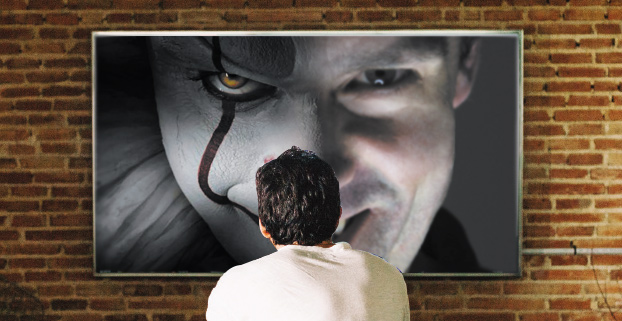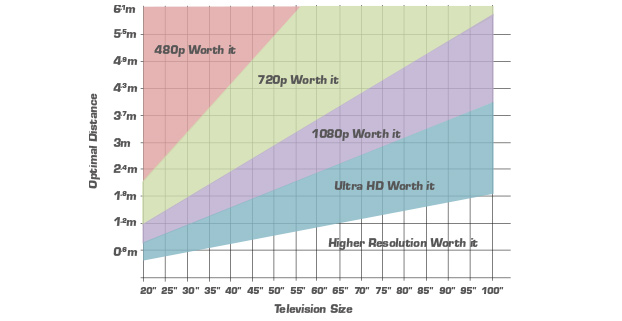
UHD or 4K is the buzz word of the TV industry, yet I’m afraid that unless you’re buying a big TV it’s probably not important. 4K refers to resolution or the number of pixels or dots on the TV. In most cases, the magic number is 3840 pixels (hence 4k) across the bottom of the TV screen and 2160 pixels up the screen. Most people would agree that more dots is better. It’s clearer. You can walk up to any TV in any showroom and appreciate the difference between yesterday’s Full HD (1920×1080) and today’s 4K (3840×2160). Which is absolutely true, but at the same time, completely wrong.
You need to view resolution in conjunction with an Optimal Viewing Distance chart. This article that you’re reading maybe perfectly clear at your arm’s length, but from the end of your street, the text appears imperceptibly small. If we consider a 55” TV as the “standard” size, then 4K or Full HD on a 55” TV would be difficult to pick apart at a standard viewing distance of 2.4m. After all, the pixels on the Full HD TV will only be around half a millimetre wide. The 4K pixel is a third of a millimetre. At 2.4m, can you pick them apart? Probably not. So next time you compare TVs at a distance of 30cm, remember that it’s probably a pointless exercise.

The reason you SHOULD buy a 4K is for the extra features. The extra features like wide colour gamut, colour subsampling (4:4:4) and refresh rate are important, but HDR is truly awesome! HDR stands for High Dynamic Range or in layman’s, better contrast. There are 4 flavours of HDR thus far (HDR10, Dolby Vision, HLG and advanced HDR), but let’s not get bogged down. The main thing is that with HDR, you can distinguish details from within the darkest and brightest scenes of movies. I’d recommend an OLED TV for dark viewing environments or a LED TV for bright rooms, but either way, HDR content with a compatible TV is a truly exceptional combination. So when you get your next TV, look for HDR.
All of these cool features (4K, WCG, HDR, 60Hz etc.) come at a cost. They involve a lot of information and a lot of bandwidth. To be exact, 18gbps.
Companies like Pro2, Blustream, and Kordz are rushing to release 18gbps product. To assess the cost, consider the stock standard Pro2 HDMI splitter (basic 4K) at $40ex trade and the 18gbps Pro2 splitter at $65ex. The cost premium for cables is even higher as technologies like fibre optics need to be used, rather than copper.
You might be thinking, “hey, I don’t need the latest the greatest 4K TV, the best Oppo blu-ray player etc.”, but technology is moving fast now. Netflix has now released 4K with HDR. Foxtel will be releasing their 4K set-top box soon. The technology is here already, so my suggestion is to embrace 18gbps and console yourself in the thought that compared to most things in life, electronics remains to be affordable!
By Michael Swann
This write-up first appeared in our March 2018 newsletter.
Kords R.3 Rack Install HDMI Cable Series
Kords PRO Integrator HDMI Cable Series
Kords Short-Length PRS Fixed Installation HDMI Cable Series